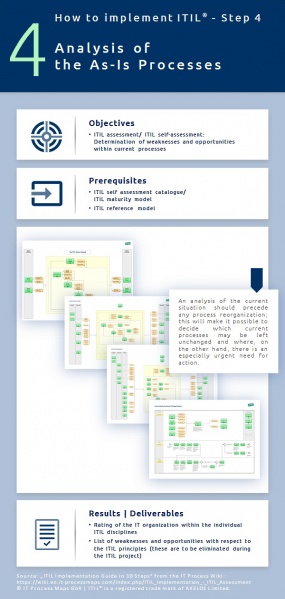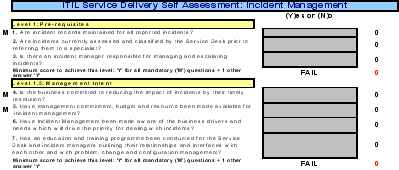ITIL Implementation - ITIL Assessment: Difference between revisions
No edit summary |
No edit summary |
||
| (2 intermediate revisions by the same user not shown) | |||
| Line 2: | Line 2: | ||
<meta name="keywords" content="itil assessment, itil self assessment, itil principles, itil assessment questionnaire" /> | <meta name="keywords" content="itil assessment, itil self assessment, itil principles, itil assessment questionnaire" /> | ||
<meta name="description" content="The ITIL self assessment is also recommendable if ITIL is to be introduced for the first time. ..." /> | <meta name="description" content="The ITIL self assessment is also recommendable if ITIL is to be introduced for the first time. ..." /> | ||
<meta property="og:url" content="https://wiki.en.it-processmaps.com/index.php/ITIL_Implementation_-_ITIL_Assessment" /> | |||
<meta property="og:title" content="ITIL Implementation - ITIL Assessment | IT Process Wiki" /> | |||
<meta property="og:description" content="The ITIL self assessment is also recommendable if ITIL is to be introduced for the first time. ..." /> | |||
<meta property="og:site_name" content="IT Process Wiki - the ITIL® Wiki"> | |||
<meta property="og:type" content="article" /> | |||
<meta property="fb:admins" content="100002035253209" /> | |||
<meta property="fb:admins" content="100002592864414" /> | |||
<meta property="og:image" content="https://wiki.en.it-processmaps.com/images/3/3b/4-itil-implementation-itil-assessment.jpg" /> | |||
<meta property="og:image:width" content="1200" /> | |||
<meta property="og:image:height" content="600" /> | |||
<link href="https://plus.google.com/108613479011811316823/posts" rel="publisher" /> | |||
</itpmch> | </itpmch> | ||
<imagemap> | <imagemap> | ||
Image:ITIL-Wiki-de-es.jpg|right|DE - ES - ITIL Assessment - ITIL Self Assessment|163px | |||
Image:ITIL-Wiki-de-es.jpg|DE - ES - ITIL Assessment - ITIL Self Assessment|163px | |||
rect 81 0 114 36 [https://wiki.de.it-processmaps.com/index.php/ITIL-Implementierung_-_ITIL-Assessment diese Seite auf Deutsch] | rect 81 0 114 36 [https://wiki.de.it-processmaps.com/index.php/ITIL-Implementierung_-_ITIL-Assessment diese Seite auf Deutsch] | ||
rect 115 0 163 36 [https://wiki.es.it-processmaps.com/index.php/Implementaci%C3%B3n_de_ITIL_-_Evaluaci%C3%B3n_de_ITIL esta página en español] | rect 115 0 163 36 [https://wiki.es.it-processmaps.com/index.php/Implementaci%C3%B3n_de_ITIL_-_Evaluaci%C3%B3n_de_ITIL esta página en español] | ||
| Line 16: | Line 21: | ||
</imagemap> | </imagemap> | ||
<br style="clear:both;"/> | <br style="clear:both;"/> | ||
[[image:Analyzing-the-as-is-processes-itil-step-4.jpg|thumb|285px|right|alt=Analysis of As-Is Processes: ITIL Assessment / ITIL Self Assessment. ITIL implementation, step 4.|link=https://wiki.en.it-processmaps.com/index.php/File:Analyzing-the-as-is-processes-itil-step-4.jpg|[[Media:Analyzing-the-as-is-processes-itil-step-4.jpg|Infographic: Analysis of as-is processes - ITIL assessment. - ITIL implementation, step 4.]]]] | |||
{| | {| | ||
|- | |- | ||
|style="border-bottom:1px solid grey;"| | |style="border-bottom:1px solid grey; font-size:130%"|<strong>Step 4: Analysis of As-Is Processes: ITIL Assessment / ITIL Self Assessment</strong> | ||
|} | |} | ||
<p> </p> | <p> </p> | ||
An analysis of the current | An analysis of the current processes should precede any process reorganization; this will make it possible to decide which current processes may be left unchanged and where, on the other hand, there is an especially urgent need for action. | ||
===<span id="Objective of this Project Step">Objectives</span>=== | ===<span id="Objective of this Project Step">Objectives</span>=== | ||
* Determination of weaknesses and opportunities within current processes | * Determination of weaknesses and opportunities within current processes | ||
<p> </p> | |||
< | __TOC__ | ||
<br style="clear:both;"/> | |||
==Description== | ==Description== | ||
At times organizations choose to painstakingly document their existing processes when they go about analyzing the current situation. | |||
We have experienced that this effort does not usually justify the means | We have experienced that this effort does not usually justify the means. Too much focus on the current, often outdated working practices tends to obstruct one's sight when redesigning processes towards simpler, more effective ways. | ||
Instead, we recommend evaluating the current processes | Instead, we recommend identifying weaknesses and opportunities by evaluating the current processes against best practice. | ||
The ITIL® Process Map provides a solid basis for this task. For every process, the ITIL process model describes its interfaces and the process activities. This allows identifying possible issues by comparing the organization's current processes with the ITIL recommendations. | |||
There are also a number of publications available for self-assessment, especially against ITIL and ISO/IEC 20000. | |||
==Prerequisites== | ==Prerequisites== | ||
[[image:thumb_ITIL_assessment.jpg|thumb|399px|right|alt=ITIL Self Assessment|link=https://wiki.en.it-processmaps.com/index.php/File:Thumb_ITIL_assessment.jpg|Fig. 1: ITIL Self Assessment Catalogue]] | |||
* ITIL reference process model / The [https://en.it-processmaps.com/products/itil-process-map.html ITIL Process Map] | |||
*ITIL v2 Self Assessment Catalogue (previously available free of charge on the itSMF web site; it can still be found on the internet by searching for 'Self Assessment (ITIL V2)') | *ITIL v2 Self Assessment Catalogue (previously available free of charge on the itSMF web site; it can still be found on the internet by searching for 'Self Assessment (ITIL V2)') | ||
<br style="clear:both;"/> | |||
< | |||
==Results/ Deliverables== | ==Results/ Deliverables== | ||
* List of weaknesses and opportunities to be addressed by the introduction of ITIL-aligned processes. | |||
*List of weaknesses and | |||
==Success | ==Success factors== | ||
* | * Staff from various levels of the service provider organization, including top management, should take part in the assessment, to ensure that strategic as well as operational viewpoints are considered. | ||
==Resources== | ==Resources== | ||
*[1] [[ITIL Processes|ITIL processes - ITIL process descriptions]] | |||
*[2] AXELOS: The ITIL Maturity model and self-assessment service | |||
*[3] ITIL Self Assessment Catalogue | |||
==Following project activity== | |||
→ ITIL Implementation - step 5: '''[[ITIL Implementation - Process Structure|Definition of the to-be process structure]]''' | |||
== | ==Notes== | ||
&# | <html>By:  Andrea Kempter <a rel="author" href="https://www.linkedin.com/in/andreakempter"><img style="margin:0px 0px 0px 0px;" src="/images/bookmarking/linkedin.png" width="16" height="16" title="By: Andrea Kempter | Profile on LinkedIn" alt="Author: Andrea Kempter, IT Process Maps GbR" /></a>, IT Process Maps. | ||
<p> </p> | <p> </p> | ||
== | <p><small> | ||
<span itemprop="breadcrumb" itemscope itemtype="http://schema.org/BreadcrumbList"> | |||
<span itemprop="itemListElement" itemscope itemtype="http://schema.org/ListItem"> | |||
<a itemprop="item" href="https://wiki.en.it-processmaps.com/index.php/ITIL_Implementation_-_ITIL_Assessment#Objectives"> | |||
<span itemprop="name">Objectives</span></a> | |||
<meta itemprop="position" content="1"></span> › | |||
<span itemprop="itemListElement" itemscope itemtype="http://schema.org/ListItem"> | |||
<a itemprop="item" href="https://wiki.en.it-processmaps.com/index.php/ITIL_Implementation_-_ITIL_Assessment#Description"> | |||
<span itemprop="name">Description</span></a> | |||
<meta itemprop="position" content="2"></span> › | |||
<span itemprop="itemListElement" itemscope itemtype="http://schema.org/ListItem"> | |||
<a itemprop="item" href="https://wiki.en.it-processmaps.com/index.php/ITIL_Implementation_-_ITIL_Assessment#Prerequisites"> | |||
<span itemprop="name">Prerequisites</span></a> | |||
<meta itemprop="position" content="3"></span> › | |||
<span itemprop="itemListElement" itemscope itemtype="http://schema.org/ListItem"> | |||
<a itemprop="item" href="https://wiki.en.it-processmaps.com/index.php/ITIL_Implementation_-_ITIL_Assessment#Results.2F_Deliverables"> | |||
<span itemprop="name">Results/ Deliverables</span></a> | |||
<meta itemprop="position" content="4"></span> › | |||
<span itemprop="itemListElement" itemscope itemtype="http://schema.org/ListItem"> | |||
<a itemprop="item" href="https://wiki.en.it-processmaps.com/index.php/ITIL_Implementation_-_ITIL_Assessment#Success_factors"> | |||
<span itemprop="name">Success factors</span></a> | |||
<meta itemprop="position" content="5"></span> | |||
</span> | |||
</small></p> | |||
< | <!-- define schema.org/WebPage --> <span itemscope itemtype="https://schema.org/WebPage"> | ||
< | <meta itemprop="name" content="ITIL Implementation - ITIL Assessment" /> | ||
< | <meta itemprop="description" content="The ITIL self assessment is also recommendable if ITIL is to be introduced for the first time. ..." /> | ||
< | <link itemprop="url" href="https://wiki.en.it-processmaps.com/index.php/ITIL_Implementation_-_ITIL_Assessment" /> | ||
< | <meta itemprop="inLanguage" content="en" /> | ||
<link itemprop="citation" href="https://wiki.de.it-processmaps.com/index.php/ITIL-Implementierung_-_ITIL-Assessment" /> | |||
<link itemprop="citation" href="https://wiki.es.it-processmaps.com/index.php/Implementaci%C3%B3n_de_ITIL_-_Evaluaci%C3%B3n_de_ITIL" /> | |||
<meta itemprop="Headline" content="ITIL Implementation - ITIL Assessment" /> | |||
</ | <meta itemprop="alternativeHeadline" content="Step 4: Analysis of As-Is Processes: ITIL Assessment / ITIL Self Assessment" /> | ||
< | <link itemprop="primaryImageOfPage" href="https://wiki.en.it-processmaps.com/images/9/98/Thumb_ITIL_assessment.jpg" /> | ||
<link itemprop="author" href="https://www.linkedin.com/in/andreakempter" /> | |||
<meta itemprop="author" content="Andrea Kempter" /> | |||
< | <meta itemprop="creator copyrightHolder publisher" content="IT Process Maps" /> | ||
</span><p></html> | |||
</ | |||
< | |||
<!-- This page is assigned to the following categories: --> | <!-- This page is assigned to the following categories: --> | ||
[[Category:ITIL V3]][[Category:ITIL 2011]][[Category:ITIL implementation]] | [[Category:ITIL V3]][[Category:ITIL 2011]][[Category:ITIL implementation]] | ||
<!-- --- --> | <!-- --- --> | ||
Latest revision as of 15:21, 5 April 2022


| Step 4: Analysis of As-Is Processes: ITIL Assessment / ITIL Self Assessment |
An analysis of the current processes should precede any process reorganization; this will make it possible to decide which current processes may be left unchanged and where, on the other hand, there is an especially urgent need for action.
Objectives
- Determination of weaknesses and opportunities within current processes
Description
At times organizations choose to painstakingly document their existing processes when they go about analyzing the current situation.
We have experienced that this effort does not usually justify the means. Too much focus on the current, often outdated working practices tends to obstruct one's sight when redesigning processes towards simpler, more effective ways.
Instead, we recommend identifying weaknesses and opportunities by evaluating the current processes against best practice.
The ITIL® Process Map provides a solid basis for this task. For every process, the ITIL process model describes its interfaces and the process activities. This allows identifying possible issues by comparing the organization's current processes with the ITIL recommendations.
There are also a number of publications available for self-assessment, especially against ITIL and ISO/IEC 20000.
Prerequisites

- ITIL reference process model / The ITIL Process Map
- ITIL v2 Self Assessment Catalogue (previously available free of charge on the itSMF web site; it can still be found on the internet by searching for 'Self Assessment (ITIL V2)')
Results/ Deliverables
- List of weaknesses and opportunities to be addressed by the introduction of ITIL-aligned processes.
Success factors
- Staff from various levels of the service provider organization, including top management, should take part in the assessment, to ensure that strategic as well as operational viewpoints are considered.
Resources
- [1] ITIL processes - ITIL process descriptions
- [2] AXELOS: The ITIL Maturity model and self-assessment service
- [3] ITIL Self Assessment Catalogue
Following project activity
→ ITIL Implementation - step 5: Definition of the to-be process structure
Notes
By: Andrea Kempter ![]() , IT Process Maps.
, IT Process Maps.
Objectives › Description › Prerequisites › Results/ Deliverables › Success factors






